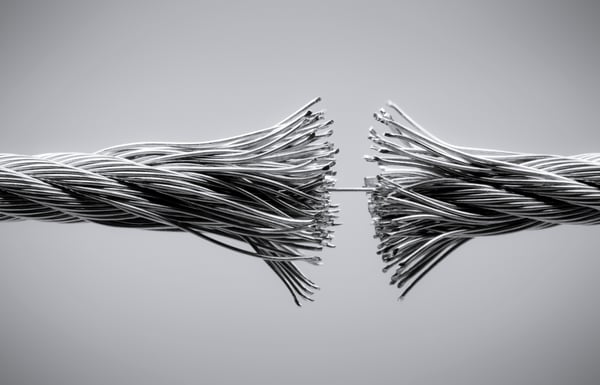In this blog, we will cover three common forms of wear and tear that wire can experience out in the field. Though wear does occur naturally, regular inspection, maintenance, and equipment repair can help ensure appropriate cycle life for your cable products while also minimizing risks and failures. Be on the lookout for signs of abrasion, bird caging, and kinking as you inspect and operate your equipment.

Abrasion, Peening, & Corrosion
Abrasion, peening, and corrosion typically impact the outer surfaces of wire rope. Abrasion is a form of metal loss or erosion, and peening describes metal deformation. Both of these phenomena occur when a wire rope contacts other metallic surfaces, or when it passes over a drum or sheave. Sheaves that are heavily worn or badly corrugated can expedite wear and friction, causing the individual cable wires to break down and press together. Additionally, when sheaves are poorly lubricated, they cause pitting in the cable surface that leaves them vulnerable to corrosion and rust. Even a brand new cable is susceptible to premature wear if they are not maintained correctly, and paired with appropriate pulleys.
Bird Caging
Bird caging is a severe form of wire rope distortion that causes the individual outer strands of a cable to unravel and expand, creating a bird cage shape at the damage site. Bird caging is usually caused by sheaves that impart unintentional rotation. When a non-rotation resistant cable experiences torsion caused by excessively tight, or incorrectly positioned sheaves, it triggers the outer cable strands to lift away from their normal position. Bird caging poses a severe hazard. To prevent future issues, the damaged cable should be immediately removed from operation, and the sheaves remedied.
Kinks
A kink is the permanent deformation of strands in a wire rope caused by unintended bending and twisting. This usually occurs when the rope is twisted into a tight loop and then snapped back to a straight direction, leaving a permanent curve at the bend site. Though kinks often result from improperly handling or installing wire rope, they can also appear during service if a heavy load is released suddenly, or if a wire rope bends around too small of a sheave. While most kinks show obvious signs of catastrophic failure, others may appear insignificant or repairable through re-straightening. However, it is important to note that kinks always result in permanent strand damage, no matter how severe they may seem on the surface. If not addressed in a timely manner, kinks pose a severe safety hazard.
Though cable damage may happen unexpectedly, you can set yourself up for success by employing high quality wire rope from the start. Luckily, Strand Core manufactures high quality domestic aircraft cable and wire rope for military and commercial applications. Start a quote today, or contact us with any questions at https://strandcore.com/contact/.

